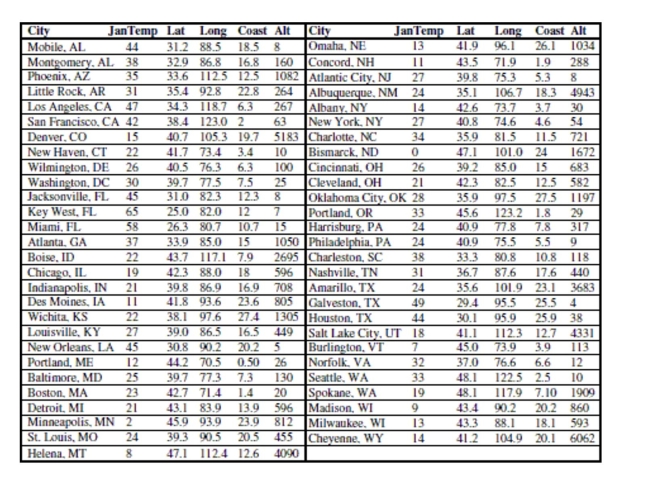Here are data about the average January low temperature in cities in the United States, and factors that might allow us to
predict temperature. The data, available for 55 cities, include:  We will attempt to make a regression model to help account for mean January temperature and to understand the effects of
We will attempt to make a regression model to help account for mean January temperature and to understand the effects of
the various predictors.
At each step of the analysis you may assume that things learned earlier in the process are known.
Units Note: The "degrees" of temperature, given here on the Fahrenheit scale, have only coincidental language relationship to
the "degrees" of longitude and latitude. The geographic "degrees" are based on modeling the Earth as a sphere and dividing it
up into 360 degrees for a full circle. Thus 180 degrees of longitude is halfway around the world from Greenwich, England
(0°) and Latitude increases from 0 degrees at the Equator to 90 degrees of (North) latitude at the North Pole. 
-Here is the corresponding regression table: Dependent variable is: JanTemp
squared squared (adjusted)
with degrees of freedom
Write a brief report based on this regression. Explain in words and numbers what this
equation says about the relationship between average January low temperature and
latitude. Discuss the R2 value and t-ratios.
Definitions:
Turnover Rates
The rate at which employees leave a company within a certain period, which can be an indicator of job satisfaction and organizational health.
Validity of Data
Pertains to the accuracy and credibility of data or information, ensuring it is sourced and interpreted correctly for decision-making.
Compensation Levels
Refers to the tiers or categories of payment provided to employees, often based on their role, experience, and performance, within an organization.
Wage Gap
The difference in average earnings between different groups of workers, often highlighted between genders, races, or socioeconomic statuses.
Q7: The histogram below represents the number of
Q10: What can you conclude about the
Q13: Check the conditions for the regression and
Q14: The ages of the 45 members
Q24: The normal monthly precipitation (in inches)
Q39: "38% of adults in the United States
Q43: Food inspectors need to estimate the level
Q47: A teacher was interested in knowing how
Q49: Identify the value of the test
Q65: Explain the computation of expected values for